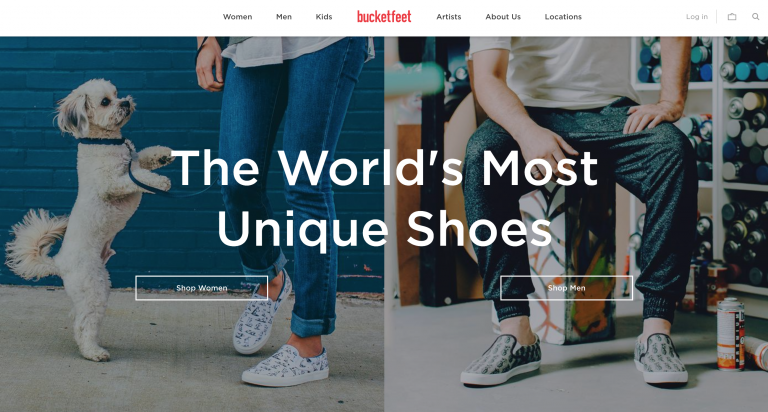Check out what he has to say below.
Four reasons why there has never been a better time to launch or become an omnichannel retailer.
According to Sandy, here are the top reasons why now is a great time to launch a retail business:
1. Low barrier to entry
“The barrier to entry has never been lower,” says Sandy. According to him, the internet has had a flattening effect on the industry, and as a result, “even the smallest retailer” has tremendous opportunity to launch and thrive.
Costs are also lower. “The advertising costs have never been lower, because of the power of social media. Independents can develop a following at a relatively low cost if they have a product or service that people are passionate about.”
“Access to both software and hardware to empower selling is also cheaper, and it enables small retailers to develop a bond and an understanding of what their customers want. That, in turn, lets them offer a high level of product and service.”
2. Shoppers are drawn to SMB retailers
Secondly, Sandy says that shoppers today are more inclined to prop up small businesses.
“You’ve got the Shop Small movement. You’ve got the Buy Local movement. There are companies like American Express supporting small business people. Independent retailers really excel at building relationships with customers.”
“We’ve watched even independent booksellers go from having a really terrible time to becoming a healthy niche. Even a bookseller in this day and age that’s well-focused can succeed, and many of the indies that’s survived the retail shake-out are building new stores.”
Smaller retailers also have a lot going for them in the marketing and customer service departments.
“The opportunity for proximity marketing, and keeping that hyperlocal focus is easy for a small business as it is for large. If they’re playing their cards right, they’re going to have higher margins, which is going to allow for additional investments. ”
3. Digital natives have a huge advantage
If you already have an online brand or store, then you’re in a great position to set up shop offline.
Sandy points to retailers such as Warby Parker and Shinola, which started off as online pure-plays, but successfully opened offline stores because they had a unique concept and a passionate customer base.
4. There are many product and service niches yet to be discovered
“I believe there are still many product and service niches that businesses can develop into viable and successful retail concepts,” says Sandy.
Some of these include craft movements and make-tailing, outdoor activities with immersive discovery, artisanal foods and beverages, and more.
Key takeaways:
- Technology and the web have lowered the barrier to entry for merchants, and have made it easy and cost-effective to launch businesses.
- There are also plenty of movements in favor SMBs, so startups and small businesses have plenty of support.
- There are still many profitable niches that businesses can tap into. Some of these include craft movements and make-tailing, outdoor activities with immersive discovery, artisanal foods and beverages, among others .
The 5 traits every retailer needs to succeed in today’s market
While the retail industry offers plenty of opportunities for merchants, it’s still a highly competitive environment. Here are the traits you need to win in the current retail landscape:
1. Be an experience-first type of store
Emotions drive the sale, says Sandy, which is why he advises retailers to put the customer experience first. As the founder of his own retail design firm, Sandy shares that they often helped their clients rebrand and deal with commoditization
“If price is your only differentiator, then you have a commodity. You don’t have something special, so it becomes a race to the bottom.”
How can you overcome commoditization? He says you need to think about your shoppers and create experiences around your product so you go from commodity-based selling to solution-based selling.
“Here’s a good example. We had a client that sold aftermarket parts for pickup trucks and jeeps. People would buy their products to improve the look and performance of their cars. We explained to them that their stores looked just like others parts stores, and they were not leveraging the emotional connection a customer has with their vehicle.”
“[The client] had to create an emotion around the sale, and talk about how a customer likes to use their vehicle, rather than the part they’re trying to find.”
Doing this allows retailers to build a bond with the shopper and create customer lifetime value.
“Another part of experience-first is creating immersive experiences that are tied to things that people like to do, he adds.
“[For instance,] as baby boomers age and retire, we want to bond with millennial kids. To address this, companies that are selling things for outdoor experience could create concierge services (e.g., vacation planning, immersive destination experiences). These things emphasize the experience over the product, which then leads to improving the lifetime customer value over the transactional value.”
Key takeaways:
- Make an emotional connection with shoppers.
- For instance, a car parts store can use the emotional connection that customers have with their car, instead of just focusing on the product.
- Create experiences around what you’re selling. This helps quash commoditization and grows customer lifetime value.
For example, an outdoor retailer can launch vacation planning, which puts more focus on the experience over their product.
2. Be authentic
The second trait is authenticity. As Sandy puts it, these days, “we’re all looking for more value in our life than just acquiring stuff. There’s been a tremendous movement toward products that express authentic values and stories.”
“My friend Joe Pine, who wrote The Experience Economy, says, ‘You can’t tell somebody it’s authentic. If you do, it isn’t authentic.’”
“In other words, a business has to feel authentic. It has to have all of the earmarks of authenticity.”
One example of an authentic retailer? Shinola, an upscale merchant that sells watches, bikes, leather goods, and curated gift items.
“Their founder created the term “make-tailing,” which highlights the craftsmanship and the training they do to enable people that have been out of work to find a new craft and to build their products in the United States.”
“All of their products are handmade and assembled by people who in many cases hadn’t previously had a job. As a result, Shinola has high brand value because it is authentic and it revolves around things that have a lasting value in terms of their quality.”
Key takeaways:
- Consumers don’t want just “stuff.” When they buy tangible products, they want those items to either tell a story, fit into their lifestyle, be unique, or all of the above.
- Take advantage of this trend by highlighting the stories and people behind your products.
- Be human and be real.
3. Be an authority in your niche
Being an authority in your category and having a deep and unparalleled understanding of your niche will help you stay competitive. Being laser focused “enables you to create the perception that you’re the place to go,” mentions Sandy.
Many retailers accomplish this through things like mass customization.
“Again, Shinola’s really good at this. You go into the store and you can build your own watch. You can pick the face you want, the body of the watch you want, and the type of band you want. You’re making the product just for you, and that gives you a sense of high personal connection.”
Sandy also mentions Bucketfeet, a footwear retailer that has grown its authority by enabling customers to personalize their shoes. They “hire designers all over the world to create designs that go on their shoe in limited production, and give each one of those designers a small amount of the sale of every shoe.”

Bucketfeet even has an area within their store where people can come in in groups. They start with a white shoe, decorate it, and take it with them. That type of personalization gives a higher margin, a more special product, and a personal connection with the brand.”
Key takeaways:
- Stay competitive by becoming an authority in your category. You want to be the “go-to” retailer in your niche.
- A good way to accomplish this is through mass customization. Enable your customers to easily build and customize their purchases.
4. Promote sustainability
“Sustainability has to be built into the brand,” says Sandy. “Sourcing, manufacturing, and distribution all have to make efficient use of products, energy, and people — aka the triple bottom line of people, planet and profit.”
Consider what jewelry retailer Kendra Scott is doing. The company was about sustainability from day one, shares Sandy.

“They’re very big into giving back. In 2016, Kendra donated to over 3500 organizations throughout the world. They have three components to their business: family, fashion, and philanthropy. She treats her associates and her customers like family. That bond creates the basis for a culture that has been heralded as having amazing brand value because of how she runs her business.
Key takeaways:
- More and more shoppers are choosing products that are sourced responsibly.
- Engage these consumers by demonstrating ethical business practices.
- Ensure your products are created through ethical means and treat your employees well.
5. Be channel agnostic
“Channel agnosticism should be built into the culture. In this day and age, it’s no longer a case of either/or when it comes to shopping online or in-store. There’s almost no future in retail that doesn’t transact in every space, in every platform from online to in-store, and back and forth.”
He adds, that “understanding how that works is really essential, and culture has to lead the technology. There’s a lot going on right now in terms of bringing technology into retail. There’s a lot of companies that are falling all over themselves, trying to figure out what they’re going to do with all the newest technology.”
“But unless you start with a culture that understands how omnichannel works, you’re never going to have the right technology. [Having a channel agnostic culture] enables you to make appropriate investments in technology, so you can then teach it through your entire business, and empower salespeople to use tech to provide a customer-first experience.”
Key takeaways:
- Being omnichannel or channel agnostic isn’t just about the technology — it’s really about your company culture.
- Everyone in your organization must truly understand what it means to be omnichannel. This will help you make the right decisions in terms of technology, sales, training, and more.


